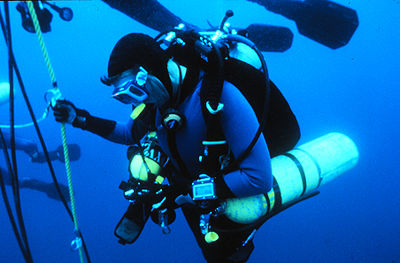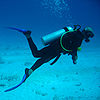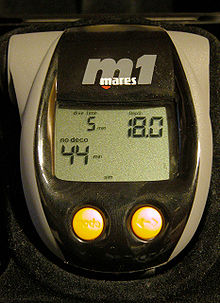- Dive computer
-
A dive computer or decompression meter is a device used by a scuba diver to measure the time and depth of a dive so that a safe ascent profile can be calculated and displayed so that the diver can avoid decompression sickness.[1]
Contents
Purpose
Dive computers address the same problem as decompression tables, but are able to perform a continuous calculation of the partial pressure of inert gases in the body based on the actual depth and time profile of the diver.[1] As the dive computer automatically measures depth and time, it is able to warn of excessive ascent rates and missed decompression stops and the diver has less reason to carry a separate dive watch and depth gauge. Many dive computers also provide additional information to the diver including air and water temperature, data used to help prevent oxygen toxicity, a computer-readable dive log, and the pressure of the remaining breathing gas in the diving cylinder. This recorded information can be used for the diver's personal log of their activities or as important information in medical review or legal cases following diving accidents.[2][3]
Because of the computer's ability to continually re-calculate based on changing data, the diver benefits by being able to safely remain underwater for longer periods of time. For example, a recreational diver who plans to stay within "no-decompression" limits can in many cases simply ascend a few feet each minute, while continuing the dive, and still remain within safe limits, rather than adhering to a pre-planned bottom time and ascending directly. So-called multi-level dives can be planned with traditional dive tables, but the additional calculations become complex and the plan may be cumbersome to follow. Computers allow for a certain amount of spontaneity during the dive.
History
 Uwatec Aladin Pro dive computer showing the log of a previous dive
Uwatec Aladin Pro dive computer showing the log of a previous dive
The Office of Naval Research funded a project with the Scripps Institute of Oceanography for the theoretical design of a prototype decompression analog computer. The Foxboro Decomputer, Mark I was manufactured by the Foxboro Company and evaluated by the US Navy Experimental Diving Unit in 1957.[4] Confusion between the diffusivity coefficient and the then new concept of tissue half time resulted in a device that did not properly mirror decompression status. Had this error not occurred, the U.S. Navy Tables might never have been developed, and divers might have been using instrumentation to control their dives from 1957 on.
The first recreational mechanical analogue dive computer, the "decompression meter" was designed by the Italians De Sanctis & Alinari in 1959 and built in their factory named SOS, which also made depth gauges. The decompression meter was distributed directly by SOS and also by scuba diving equipment firms such as Scubapro and Cressi. It was very simple in principle: a waterproof bladder filled with gas inside a big casing bled into a smaller chamber through a semi-porous ceramic cartridge (to simulate tissue in/out gassing). The chamber pressure was measured by a bourdon tube, calibrated to indicate decompression status. The device functioned so poorly that it was eventually nicknamed "bend-O-meter".
In 1965, Stubbs and Kidd applied their decompression model to a pneumatic analogue decompression computer.[5][6]
Several analogue decompression meters were subsequently made, some with several bladders for illustrating the effect on various body tissues, but they were sidelined with the arrival on the scene of electronic computers.
In 1980/81, the Hans Hass DecoBrain, designed and invented by D.I. Juergen Hermann a Swiss electronic engineer, became the first popular decompression diving computer, capable of displaying the information that today's diving computers do. The Deco Brain was based on Prof. Dr. A. Bühlmann's 16 compartment (ZHL-12) tissue model[7] which Hermann implemented on one of Intel's first single-chip microcontrollers as part of his thesis at the Swiss Institute of Technology. Hermann marketed the Deco Brain from 1982 on; in the following years he miniaturized diving computers to the size of a match box (called Micro Brain, DC11, DC12, TRAC and others), and finally sold his company, Divetronic AG, to Scubapro for several million US dollars in 1991. Today, Scubapro/Uwatec is still one of the leading diving computer manufacturers.
The 1984 Orca EDGE was an early example of a no-decompression computer.[7] The EDGE was unable to display a decompression plan, but instead the EDGE showed the ceiling or the so-called "safe-ascent-depth". If the diver was faced by a ceiling, he did not know how long he would have to decompress. At that time, only the Deco Brain was able to compute and display a decompression plan, displaying the total ascent time, the related decompression stops and decompression times.[8]
In 1984 D.I. Juergen Hermann also developed the US Navy diving computer (UDC) which was based on a 9 tissue model of Dr. Edward D. Thalmann of the Naval Experimental Diving Unit (NEDU), Panama City, who developed the US Navy tables. Hermann completed the UDC development – as it had been started by the chief engineer Kirk Jennings of the Naval Ocean System Center, Hawaii, and Dr. Thalmann of the NEDU – by adapting the Deco Brain for US Navy warfare use and for their 9-tissue MK-15 mixgas model under an R&D contract of the US Navy. Divetronic also received further R&D work from the US Navy in the following years and received US Navy approval for their UDC's.
In 2001, the US Navy approved the use of Cochran NAVY decompression computer with the VVAL 18 Thalmann algorithm for Special Warfare operations.[9][10]
In 2008, the Underwater Digital Interface (UDI) was released to the market. This dive computer, based on the RGBM model, includes an underwater communication system that enables divers to transmit text messages, also featuring SOS and homing capabilities, and digital 3D compass.[11]
Display information
 Technical diver wearing a dive computer on his left wrist during a decompression stop.
Technical diver wearing a dive computer on his left wrist during a decompression stop.
Dive computers provide a variety of visual dive information to the diver.
Modern dive computers display the following information on a LCD:
- Current depth.
- Maximum depth reached on this dive.
- No stop time, the time remaining at the current depth without the need for decompression stops on ascent.
- Dive time, often measured from the end of the last longer surface interval.
Many dive computers also display additional information:
- Total ascent time
- Required decompression stop depth and time.
- Water temperature.
- Ascent rate.
- Dive profile (often not displayed during the dive, but transmitted to a personal computer).
Some computers are designed to display information from a diving cylinder pressure sensor, such as:
- Gas pressure.
- Estimated remaining air time (RAT) based on available gas, rate of gas consumption and ascent time.
Some information is only shown at the surface to avoid an information overload of the diver during the dive:
- "Time to Fly" display showing when the diver can safely board an airplane.
- Desaturation time
- A log of key information about previous dives.
- Maximum non-decompression bottom times for subsequent dives based on the partial pressure of the gases in the tissue.
- dive planning functions
Audible information
Many dive computers have warning buzzers that warn the diver of events such as:
- Excessive ascent rates.
- Missed decompression stops.
- Maximum operation depth exceeded.
- Oxygen toxicity limits exceeded.
Operation
Modern dive computers are battery-powered computers within a watertight case. These computers track the dive profile by measuring time and pressure. All dive computers measure the surrounding pressure to estimate the partial pressure of gases in the human tissue. More advanced dive computers also include additional information into the calculations, for example, the water temperature or the diving cylinder pressure.
The computer then uses the profile and a decompression algorithm to estimate the partial pressure of inert gases that has been dissolved in the diver's tissues.[12] Based on these calculations, the computer estimates when a direct ascent is no longer possible, and what decompression stops would be needed.[12]
Examples of decompression algorithms are Bühlmann tables, the Multi-Tissue Model, the Varying Permeability Model, and the Reduced Gradient Bubble Model.
Many dive computers are able to produce a safe decompression schedule for dives that take place at altitude, which requires a slower ascent than at sea level, because the computers measure the atmospheric pressure before the dive. When divers travel before or after diving and particularly when they fly, they should transport their dive computer with them in the same pressure regime so that the computer can measure the pressure profile that their body has undergone.
Algorithms
Algorithms vary by model from each manufacturer but only a few algorithms have been developed, for example the Bühlmann decompression algorithm. The algorithm used may also be a modification of an existing algorithm and may be an important consideration in the choice of a dive computer. Dive computers using the same internal electronics are often marketed under an array of brand names.
The algorithm used helps to minimise a diver's risk of decompression sickness (DCS). Diving scientists use known data that is recorded and averaged from previous divers to create an algorithm. The computer measures depth and time, then uses the algorithm to determine decompression requirements and no-stop times. An algorithm tries to account for magnitude of pressure reduction, repetitive exposures, rate of ascent, and time at altitude. Some algorithms may not be able to account for age, previous injury, ambient temperature, body type, alcohol consumption, dehydration, and other factors such as patent foramen ovale, when determining the decompression requirements, while others may attempt to compensate for temperature and workload by having sensors that monitor ambient temperature and cylinder pressure.
As of 2009[update], the newest dive computers on the market use:
- Liquivision X1: V-Planner Live: VPM-B Varying Permeability Model and GAP for X1: Bühlmann GF (Buhlman with Gradient Factors)
- Mares: Mares-Wienke Reduced Gradient Bubble Model
- Pelagic Pressure Systems: modified Haldanean/DSAT Database or Bühlmann ZHL-16C(called Z+)
- Seiko: Bühlmann ZHL-12 + Randy Bohrer
- Suunto: Suunto-Wienke Reduced Gradient Bubble Model
- Uwatec: Bühlmann ZH-L8 /ADT (Adaptive), MB (Micro Bubble), PMG (Predictive Multigas)
- Heinrichs Weikamp OSTC and DR5: Bühlmann ZHL-16 and Bühlmann ZHL-16 plus Erick Baker's Gradient Factors deep stop algorithm both for open circuit and fixed set point closed circuit rebreather.
Special purpose dive computers
Some dive computers are able to calculate decompression schedules for breathing gases other than air, such as nitrox, pure oxygen, trimix or heliox. The more basic nitrox dive computers only support one or two gas mixes for each dive. Others support many different mixes.[13]
Most dive computers calculate decompression for 'open circuit' SCUBA where the proportions of the breathing gases are constant: these are "constant fraction" dive computers. Other dive computers are designed to model the gases in some 'closed circuit' SCUBA (rebreathers), which maintain constant partial pressures of gases by varying the proportions of gases in the mixture: these are "constant partial pressure" dive computers.
Precautions
The ease of use of dive computers, however, also exposes the diver to other dangers. Dive computers allow divers to perform complex dives with little planning. This may lead divers to exceed their competence and experience by relying too much on the computer rather than proper planning, discipline and monitoring.
Many dive computers have menus, various selectable options and various display modes, which are controlled by a small number of buttons on the front of the computer. The diver should become familiar with the control of the computer on a series of shallow and undemanding dives before relying on it for more challenging dives.
For safety reasons it is recommended that a dive plan should be established before the dive and then followed throughout the dive unless the dive is aborted. This dive plan should be within the limits of the decompression tables. This increases the margin of safety, and also provides a backup decompression schedule based on the dive tables in case the computer fails underwater.[1][14][15] The main problem in establishing dive computer algorithms is that the gas absorption and release under pressure in the human body is still not completely understood. Furthermore, the risk of decompression sickness also depends on the physiology, fitness, condition and health of the individual diver.
A diver wishing to reduce the risk of decompression sickness can take a number of precautionary measures such as:
- Use dive computers with a conservative decompression model
- Use safety factors with dive computers (e.g. using a high altitude dive mode for a dive at sea level)
- Add additional deep safety stops during a deep dive
- Make a slow ascent
- Add additional shallow safety stops
- Have a long surface interval between dives
Many computers go into a "lockout" mode for 24 hours if the diver violates the computer's safety limits, to discourage continued diving after an unsafe dive. While in lockout mode, these computers will not function until the lockout period has ended. Other computers, for example Delta P's VR3, will continue to function, providing 'best guess' functionality whilst warning the diver that a stop has been missed, or stop depth exceeded.
Manufacturers
- Citizen
- Cochran Undersea Technology
- HeinrichsWeikamp (Open source)
- Heliox Technologies
- HTM Sports: Dacor and Mares
- HydroSpace Engineering
- Liquivision
- Orca Industries Inc. (No longer in business)
- Pelagic group: Aeris, Hollis and Oceanic
- Scubapro-UWATEC by Johnson Outdoors
- Seiko
- Shearwater Research
- Suunto
- uemis
- Underwater Technology Center
- VR Technology
Other retailers sell computer clones made by Seiko (Apeks, Cressi, Dive Rite, ScubaPro, Tusa, Zeagle) or Pelagic Pressure Systems (Beuchat, Genesis, Seemann, Sherwood) or Benemec Oy (A.P.Valves).
See also
References
- ^ a b c Lang, M.A. and Hamilton, Jr R.W. (1989). Proceedings of the AAUS Dive Computer Workshop. United States: USC Catalina Marine Science Center. pp. 231. http://archive.rubicon-foundation.org/4242. Retrieved 2008-05-02.
- ^ Caruso, James L (2006). "The Pathologist’s Approach to SCUBA Diving Deaths.". American Society for Clinical Pathology Teleconference. http://archive.rubicon-foundation.org/3933. Retrieved 2011-01-14.
- ^ Concannon, David. (2007). "Dive Litigation in the Electronic Age: The Importance of Preserving Dive Computer Data in the Event of an Accident". Dive Center Business 10 (6). http://www.davidconcannon.com/images/Concannon_DCB_Nov_2007.pdf. Retrieved 2011-01-14.
- ^ Searle Jr, WF (1957). "Foxboro Decomputer Mark I". United States Navy Experimental Diving Unit Technical Report NEDU-7-57. http://archive.rubicon-foundation.org/3333. Retrieved 2008-05-02.
- ^ Stubbs R.A. and Kidd D.J (1965). "A pneumatic analogue decompression computer". Canadian Institute of Aviation Medicine Report 65-RD-1. http://archive.rubicon-foundation.org/4863. Retrieved 2008-05-02.
- ^ Stubbs R.A. and Kidd D.J (1965). "Control of decompression by analogue computer". Canadian Institute of Aviation Medicine Report 65-RD-8. http://archive.rubicon-foundation.org/4864. Retrieved 2008-05-02.
- ^ a b Huggins, Karl E (1988). "Underwater decompression computers: Actual vs. Ideal.". In: Lang, MA (ed). Advances in Underwater Science...88. Proceedings of the American Academy of Underwater Sciences Eighth annual scientific diving symposium. (American Academy of Underwater Sciences). http://archive.rubicon-foundation.org/9434. Retrieved 2011-11-20.
- ^ Hermann, Jürgen (17 November 2008). "Jürgen Hermann – the Deko Brain" (in German). pp. 6–8. http://www.hermannfinance.com/hermannjuergen/DecoBrain.pdf. Retrieved 2009-10-10.
- ^ Butler, Frank K; Southerland, David (2001). "The U.S. Navy decompression computer". Undersea and Hyperbaric Medicine 28 (4): 213–28. PMID 12153150. http://archive.rubicon-foundation.org/2364. Retrieved 2008-05-02.
- ^ The U.S. Navy Decompression Computer Article by CAPT. Frank K. Butler, M.D. Director of Biomedical Research Naval Special Warfare Command
- ^ "UDI - Underwater Digital Interface". UTC Corporation. 2008. http://www.utc-digital.com/. Retrieved 2009-09-14.
- ^ a b Hamilton, RW, Jr (ed). (1995). Effectiveness of Dive Computers in Repetitive Diving. 44th Undersea and Hyperbaric Medical Society Workshop. UHMS Publication Number 81(DC)6-1-94.. Undersea and Hyperbaric Medical Society. p. 71. http://archive.rubicon-foundation.org/7998. Retrieved 2009-04-19.
- ^ Huggins KE (2006). "Evaluation of Dive Computer Options for Potential Use in 300 FSW Heliox/ Trimix Surface Supplied Scientific Diving". In Lang, MA; Smith, NE. Proceedings of Advanced Scientific Diving Workshop. Washington, DC. http://archive.rubicon-foundation.org/4657. Retrieved 2008-05-02.
- ^ McGough EK, Desautels DA, Gallagher TJ (1990). "Dive Computers and Decompression Sickness: A Review of 83 Cases". J. Hyperbaric Med 5 (3): 159–162. http://archive.rubicon-foundation.org/4415. Retrieved 2008-05-02.
- ^ McGough EK, Desautels DA, Gallagher TJ (1990). "Performance of Dive Computers During Single and Repetitive Dives: A Comparison to the US Navy Diving Tables". J. Hyperbaric Med 5 (3): 163–170. http://archive.rubicon-foundation.org/4416. Retrieved 2008-05-02.
External links
- Dive computer reviews by Scuba Diving magazine.
- Dive computer group tests by DIVERNET magazine.
- Dive computer individual tests by DIVERNET magazine.
- Dive computer reviews by DIVE magazine.
Underwater diving Types: 
Specialities: Equipment: Diving suit · Scuba set · Rebreather · Dive computer · Diver propulsion vehicle · Mask · Fins · Snorkel · Buoyancy control deviceDisciplines: Professional diving · Police diving · Military diving · Underwater photography · Underwater videographyHazards: Related: Diving decompression Diving Equipment Gases Injury Miscellaneous Algorithms - Decompression algorithm
- Bühlmann decompression algorithm
- Reduced gradient bubble model
- Thalmann algorithm
- Varying Permeability Model
Categories:
Wikimedia Foundation. 2010.


